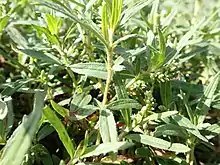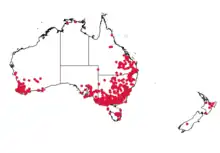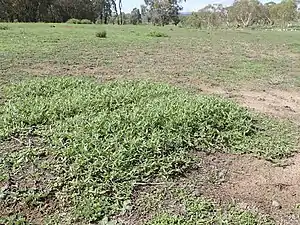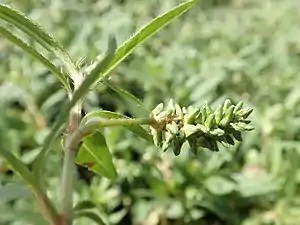Persicaria prostrata
Persicaria prostrata, basionym Polygonum prostratum, is a species of flowering plant in the family Polygonaceae, native to Australia[3] and perhaps New Zealand.[4] It is known by the common name of creeping knotweed.[5]
| Persicaria prostrata | |
|---|---|
 | |
| Scientific classification | |
| Kingdom: | Plantae |
| Clade: | Tracheophytes |
| Clade: | Angiosperms |
| Clade: | Eudicots |
| Order: | Caryophyllales |
| Family: | Polygonaceae |
| Genus: | Persicaria |
| Species: | P. prostrata |
| Binomial name | |
| Persicaria prostrata | |
 | |
| Occurrence data from AVH | |
| Synonyms[3] | |
| |
Description
Decumbent perennial herb with stems up to about 40 cm long.[5] Leaves lanceolate to narrowly elliptic, 1–5 cm long, 3–10 mm wide with short hairs on the margins and main veins.[5][6] Ochreas lobed with hairs 1–2 mm long.[5][6] Compact short cylindrical flower spikes from 0.6–4 cm long and 4–7 mm diameter.[6]
Ecology
Persicaria prostrata grows on banks of streams, ground-tanks and ditches[6] and on heavy soils in areas prone to inundation.[5]
Taxonomy
The plant was first described in 1810 by Robert Brown as Polygonum prostratum,[7][8] but was assigned to the genus Persicaria by Jiří Soják in 1974.[1][2]
Gallery
 Habitat
Habitat Habitat
Habitat Detail of leaves and ochreas
Detail of leaves and ochreas Flower spike
Flower spike Flowers
Flowers
References
- "Persicaria prostrata". Australian Plant Name Index, IBIS database. Centre for Plant Biodiversity Research, Australian Government.
- Sojak, J. (1974). "Bemerkungen zur Gattung Truellum Houtt. (Polygonaceae)" (PDF). Preslia. 46 (2): 154.
- "Persicaria prostrata (R.Br.) Soják | Plants of the World Online | Kew Science". Plants of the World Online. Retrieved 2020-03-08.
- "Persicaria prostrata | New Zealand Plant Conservation Network". Retrieved 2020-03-08.
- Stajsic, V. (2019-03-29). "Flora of Victoria: Persicaria prostrata". VICFLORA Flora of Victoria. Retrieved 2020-03-08.
- Wilson, K. L. (2014). "PlantNET - FloraOnline: Persicaria prostrata". plantnet.rbgsyd.nsw.gov.au. Retrieved 2020-03-08.
- "Polygonum prostratum". Australian Plant Name Index, IBIS database. Centre for Plant Biodiversity Research, Australian Government.
- Brown, R. (1810) Prodromus florae Novae Hollandiae et insulae Van-Diemen, exhibens characteres plantarum quas annis 1802-1805: 419
External links
 Data related to Persicaria prostrata at Wikispecies
Data related to Persicaria prostrata at Wikispecies Media related to Persicaria prostrata at Wikimedia Commons
Media related to Persicaria prostrata at Wikimedia Commons